Ferrari Purosangue First Drive Review: More than just 'the Ferrari SUV'

GARGNANO, Italy – Driving the Ferrari Purosangue for a ski day in the Dolomites makes things as clear as the northern Italian sky: If the plan is to make onlookers swivel in their ski boots, the Purosangue instantly becomes the fastest, most desirable gondola on earth. Now, all it takes is $398,350, plus roughly $50,000 to $100,000 in options, and you too can ferry a partner and adorably Moncler-clad children to frolic on the slopes of Aspen, Chamonix or here in Italy at Campiglio Dolomiti di Brenta. Just know that you may still need a roof rack despite driving history’s first Ferrari SUV.
Now, if you’re still crying about Ferrari building an “SUV,” please stop: You’re sounding like that grump who’s still shaking a fist over Porsche Cayennes, Alfa Stelvios and Mustang Mach-Es. Maybe you’re the same grump. Look, the world started flipping to SUVs about the time primitive Explorers began flipping nearly 25 years ago. The breed has morphed and evolved so many times that the old pejorative “SUV” barely describes most of today’s car-based crossovers, which hew closer to hatchbacks and wagons than Hummers and Wagoneers. That is definitely the case with the Purosangue.
Here in Italy, stylish Ferrari executives cringe only briefly at the catch-all “crossover” word, before acknowledging the designer shoe mostly fits. And one look at this Ferrari’s lightly lifted silhouette or the red-painted valve covers on its naturally aspirated V12, makes clear the Purosangue is more a genre-blurring Wonder Wagon than an SUV. A second look, this time in the scrawny cargo area behind a pair of exotically formed rear seats, suggests hatchback — at 16.7 square feet, it’s theoretically smaller than every subcompact SUV Autoblog has cargo tested. That still makes it the largest trunk found in a full-production Ferrari, and while Ferrari has a storied history of 2+2 models, including the most recent GTC4 Lusso, that “+2” typically meant two custom suitcases. Or in rare circumstances, the limber son of a divorced Monaco playboy. So in another Ferrari first, the Purosangue legitimately beckons humans into (heated, reclining) back seats, and without unduly stretching the wheelbase and spoiling its provocative front-engine, shark-snout proportions.
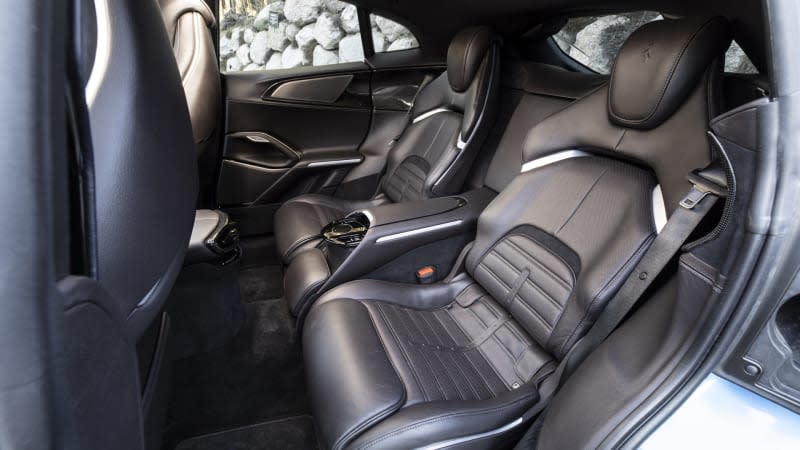
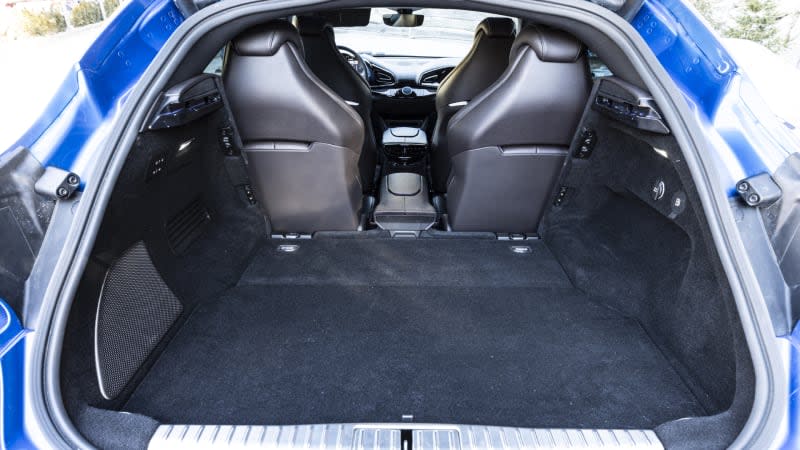
The solution is a bravura pair of rear-hinged suicide doors that motor fully open or shut with the tug of an exterior tab or the press of an interior button. A single, massive rear hinge supports each open-sesame portal. Once aboard, 6-foot adults find a reasonable perch, albeit with their heads partly inside the window cavity that borders the headliner. Again, though, after 75 years of Ferraris, this is the first that lets owners even think about putting adult friends and family in the back to enjoy a fantasy ride or dinner-for-four.
A cheeky colleague shows up at our media drive in a Lamborghini Urus Performante, but the attempt at Italian one-upping only clarifies how easy the choice would theoretically be (more on that later). The Urus is fast and brutally capable, with 641 horses versus the Ferrari’s 715, and costs $133,350 less to start. But the Lambo looks like a battering hippo (or gussied-up Audi Q8) next to the Ferrari’s sleek snow leopard. Plus, the Purosangue has a 6.5-liter, naturally aspirated, hand-built Ferrari V12, not a twin-turbo V8 sourced from Audi and Volkswagen Group. Purosangue means "thoroughbred" or more literally “pure blood” in Italian; it’s a name that isn’t without merit. Throw in the first application of Multimatic’s new active suspension, Ferrari’s trick three-speed front transaxle, four-wheel steering and an encyclopedia of F1-derived tech found on previous Ferraris, and you get the idea that this is more than the usual ultra-luxury SUV.
Inside, a slim console bisects the two rear seats, with no five-passenger capability. The console integrates a cool pop-up rotary knob with an embedded screen, repeated on the dashboard, that manages climate controls. Up front, that knob underscores a dual-cockpit layout that eschews any center screen. That puts the focus on design, materials and human-centric performance, including a stunning pair of mirror-matched binnacles for driver and passenger. The expanded cabin, surrounded by an aluminum-intensive chassis and weight-saving carbon-fiber roof (or optional electrochromic roof) makes room for the best audio system, by far, in any Ferrari: The Burmester audio system, in a first collaboration with the German audiophile brand, brings 1,420 watts and 21 speakers, including fancy ribbon tweeters and a subwoofer.
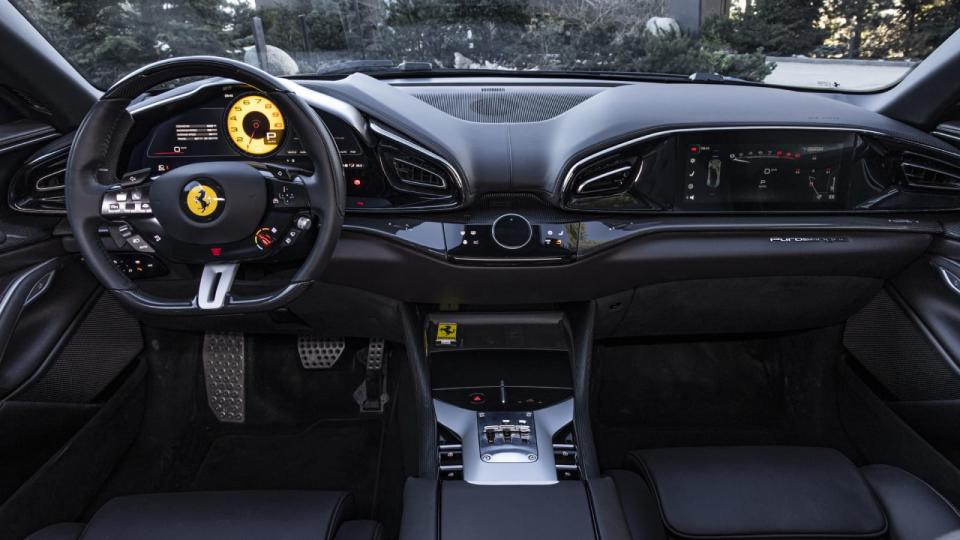
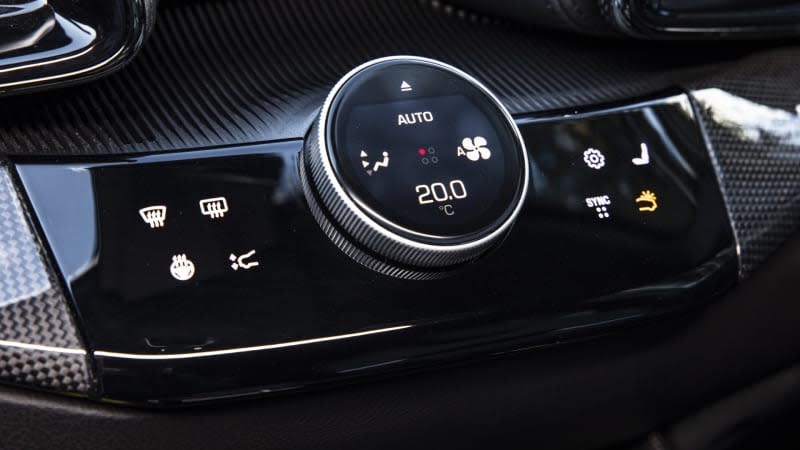
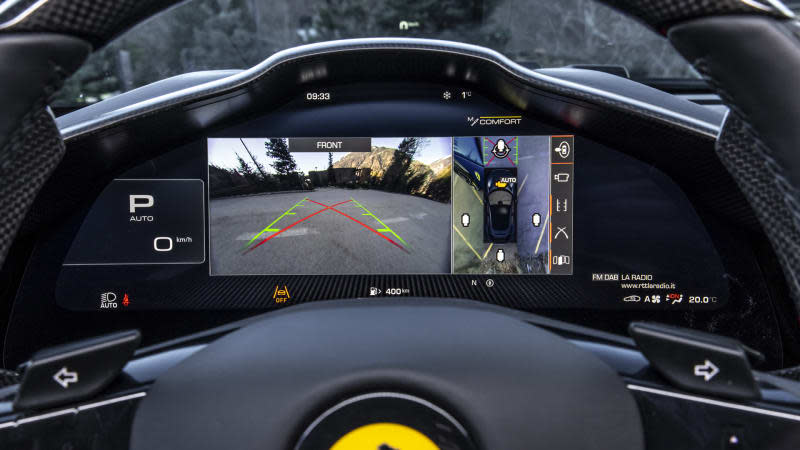
The Purosangue adopts the all-digital gauges and HMI from the rest of the Ferrari range, including a 10.3-inch passenger-side screen with expanded functionality. The driver’s screen is dominated by a 1s and 0s version of Ferrari’s classic yellow tachometer that showcases the V12 crescendo to its 8,250-rpm peak. But Ferrari asks that single screen to do way too much, including housing the phone-based navigation — wireless Apple CarPlay is onboard and wireless Android Auto is coming. There is no onboard sat-nav. Worse, that screen is managed by a fiendishly awkward thumb doohickey on the dramatic carbon-fiber-rimmed steering wheel. It's as hapless as it is haptic, stubbornly resisting commands or jumping past a desired on-screen icon. A simple scroll wheel and switch pad would be an easy improvement. Even settling on a radio station or goofing with the navigation becomes a worrying exercise in eyes-off-the-road distraction. That’s exactly what you don’t want in a half-million-dollar, 715-hp “SUV.”

 Yahoo Autos
Yahoo Autos 
